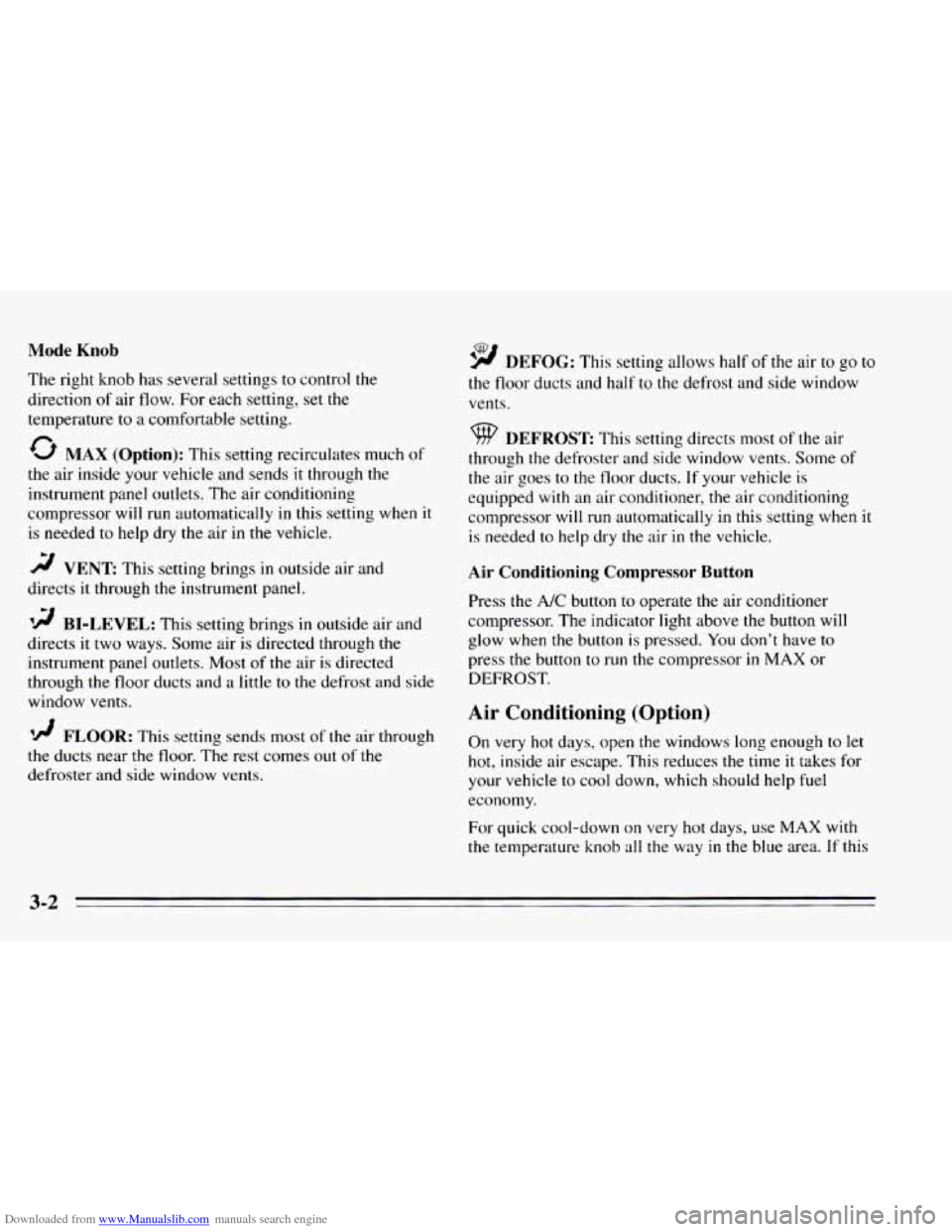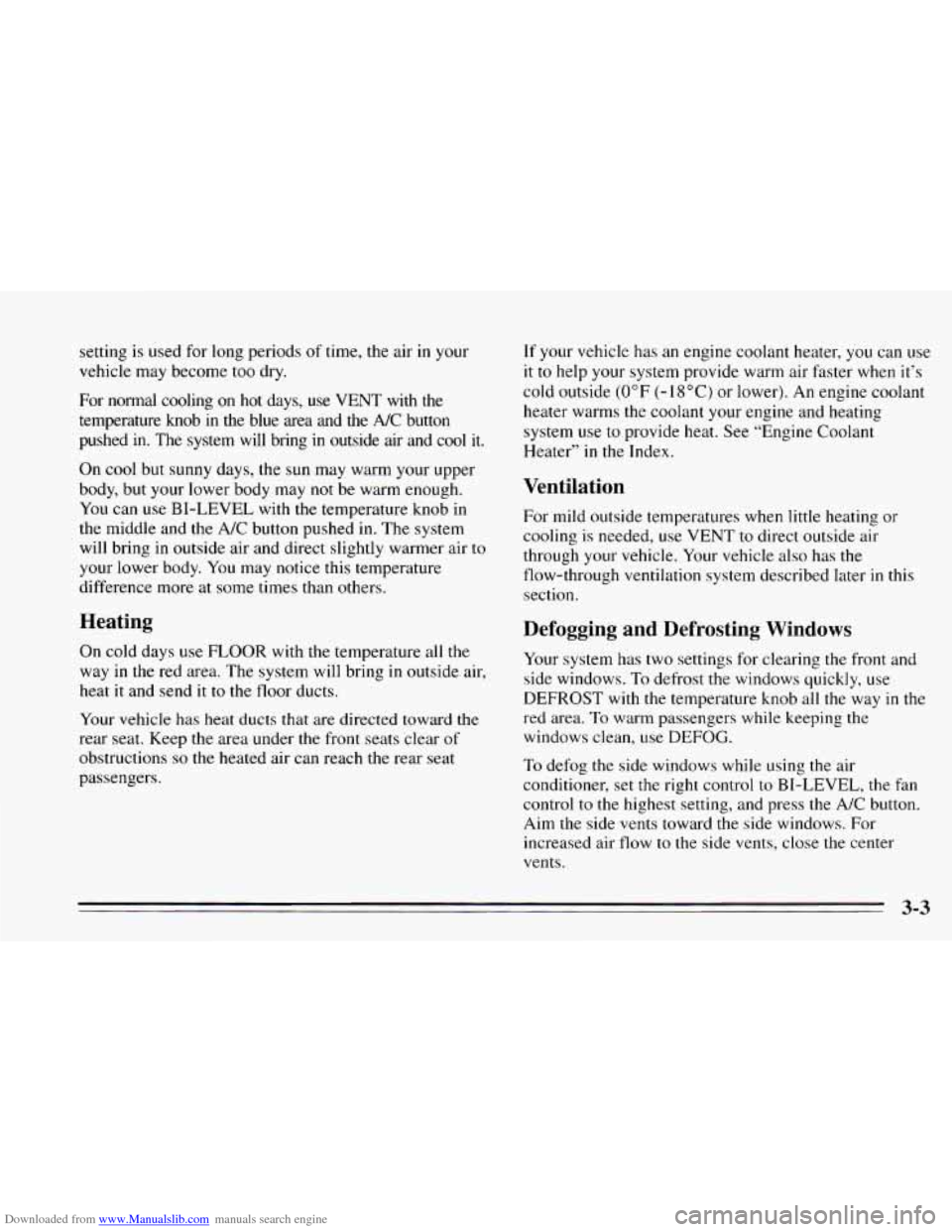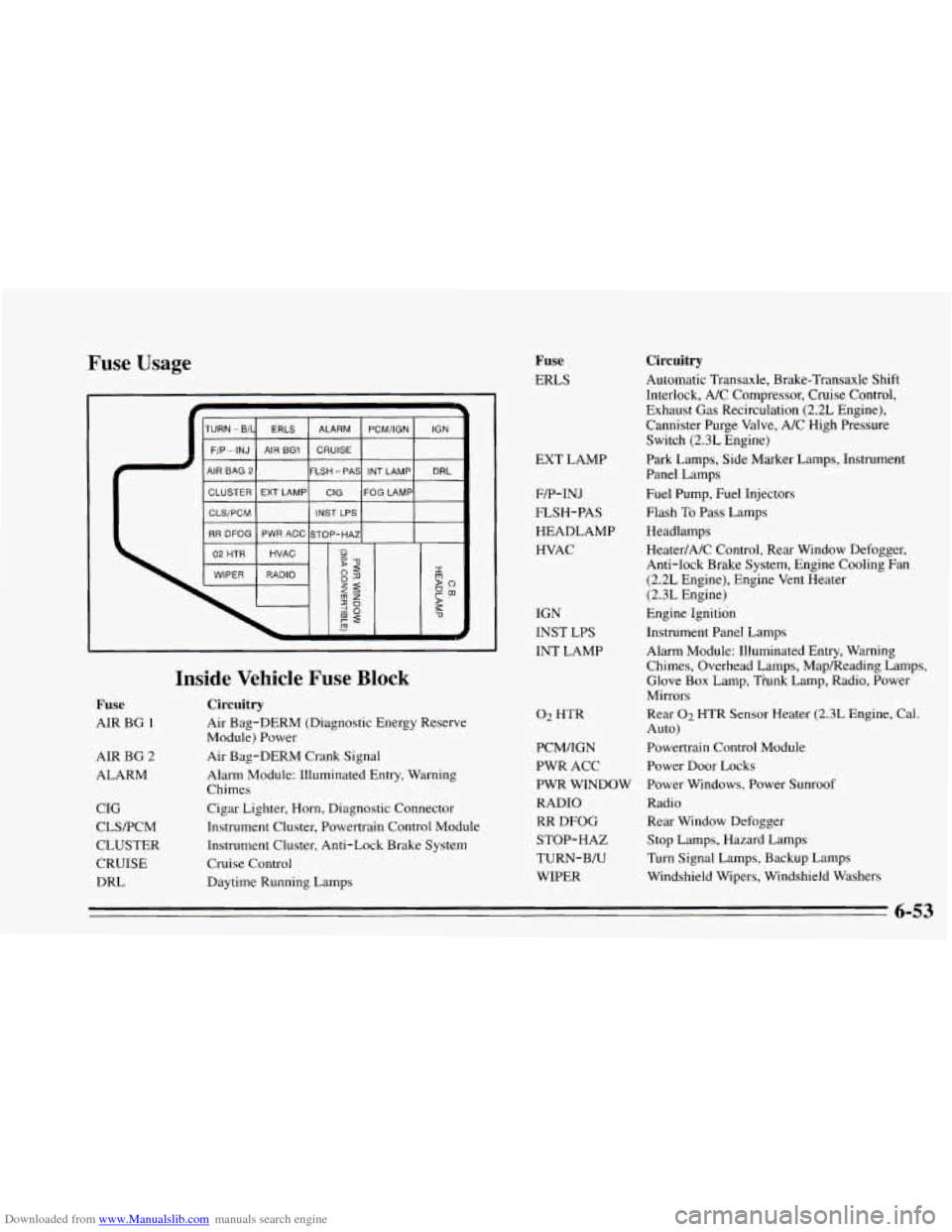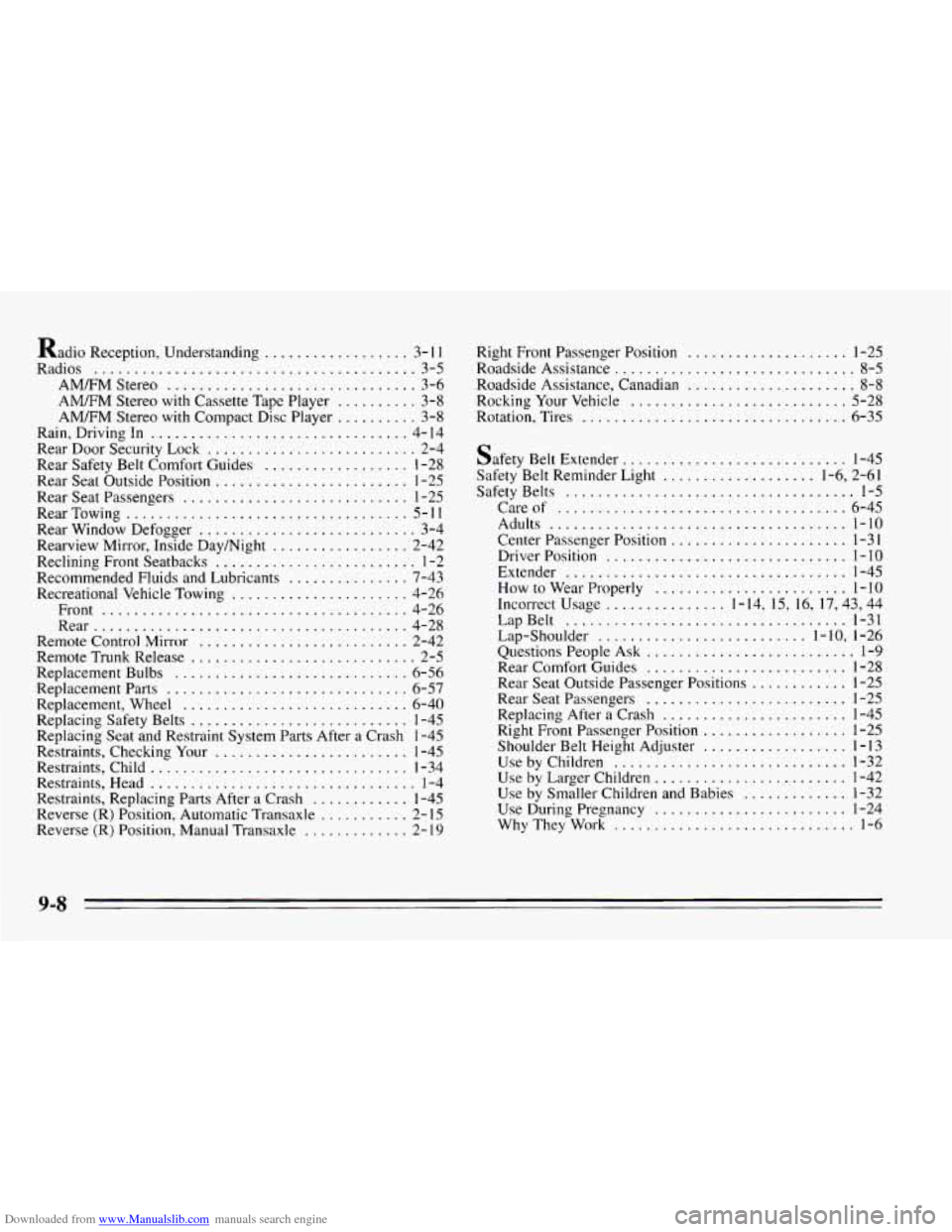1995 CHEVROLET CAVALIER fog light
[x] Cancel search: fog lightPage 10 of 340

Downloaded from www.Manualslib.com manuals search engine Vehicle Symbols
These are some of the symbols you may find on your vehicle.
For example,
these symbols are used on an
original battery:
POSSIBLE A
CAUTION
INJURY
PROTECT EYES BY
SHIELDING
Q
CAUSTIC
ACID COULD BATTERY
CAUSE
BURNS
AVOID
SPARKS
OR
FLAMES
SPARK
OR ,\I/,
COULD FLAME
EXPLODE BATTERY
These symbols
are important
for you and
your passengers
whenever your
vehicle is
driven:
DOOR LOCK
UNLOCK
FASTEN SEAT
4
BELTS
POWER
WINDOW
These symbols have to
do with
your lights:
SIGNALS 6
TURN
HIGH
LAMPSoR BEAM = =o
FOG LAMPS $0
These symbols
are on
some of
your controls:
WINDSHIELD
WIPER
i i
WINDSHIELD
WASHER I
WINDSHIELD DEFROSTER
WINDOW
DEFOGGER
VENTILATING FAN
These symbols are used on
warning and
indicator lights:
COOLANT F-
ENGINE
TEMP
--
CHARGING I-1
BATTERY SYSTEM
BRAKE
(0)
RADIATOR COOLANT
a
FUEL
ENGINE OIL
PRESSURE
Wb
TEMP OIL &
ANTI-LOCK (@)
BRAKE
Here are some
other symbols
you may
see:
FUSE
RELEASE
a
RADIO
VOLUME
CONDITIONING
AIR 43
LIGHTER HORN
)b.
SPEAKER
b
viii
Page 128 of 340

Downloaded from www.Manualslib.com manuals search engine Mode Knob
The right knob has several settings to control the
direction
of air flow. For each setting, set the
temperature to a comfortable setting.
0 MAX (Option): This setting recirculates much of
the air inside your vehicle and sends it through the
instrument panel outlets. The air conditioning
compressor will run automatically
in this setting when it
is needed to help dry the air in the vehicle.
2 VENT: This setting brings in outside air and
directs it through the instrument panel.
BI-LEVEL: This setting brings in outside air and
directs
it two ways. Some air is directed through the
instrument panel outlets. Most of the air is directed
through the floor ducts and a little
to the defrost and side
window vents.
1j FLOOR: This setting sends most of the air through
the ducts near the floor. The rest comes
out of the
defroster and side window vents.
9 DEFOG: This setting allows half of the air to go to
the floor ducts and half to the defrost and side window
vents.
9 DEFROST: This setting directs most of the air
through the defroster and side window vents. Some
of
the air goes to the floor ducts. If your vehicle is
equipped with an
air conditioner, the air conditioning
compressor will
run automatically in this setting when it
is needed to help dry
the air in the vehicle.
Air Conditioning Compressor Button
Press the A/C button to operate the air conditioner
compressor. The indicator light above the button will
glow when the button
is pressed. You don’t have to
press
the button to run the compressor in MAX or
DEFROST.
Air Conditioning (Option)
On very hot days, open the windows long enough to let
hot, inside air escape. This reduces the time it takes for
your vehicle to cool down, which should help fuel
economy.
For quick cool-down on very hot days, use
MAX with
the temperature
knob all the way in the blue area. If this
3-2
Page 129 of 340

Downloaded from www.Manualslib.com manuals search engine setting is used for long periods of time, the air in your
vehicle may become too dry.
For normal cooling
on hot days, use VENT with the
temperature knob in the blue area and the
NC button
pushed in. The system will bring in outside air and cool it.
On cool but sunny days, the sun may warm your upper
body, but your lower body may not be warm enough.
You can use BI-LEVEL with the temperature knob in
the middle and the A/C button pushed
in. The system
will bring in outside air and direct slightly warmer air to
your lower body. You may notice this temperature
difference more at some times
than others.
Heating
On cold days use FLOOR with the temperature all the
way in the red area. The system will bring in outside air,
heat it and send
it to the floor ducts.
Your vehicle has heat ducts that are directed toward the
rear seat. Keep the area under the front seats clear
of
obstructions so the heated air can reach the rear seat
passengers.
If your vehicle has an engine coolant heater, you can use
it to help your system provide warm air faster when it’s
cold outside (0°F (-18°C) or lower). An engine coolant
heater warms
the coolant your engine and heating
system use
to provide heat. See “Engine Coolant
Heater” in the Index.
Ventilation
For mild outside temperatures when little heating or
cooling is needed, use VENT to direct outside air
through your vehicle. Your vehicle also has the
flow-through ventilation system described later
in this
section.
Defogging and Defrosting Windows
Your system has two settings for clearing the front and
side windows. To defrost
the windows quickly, use
DEFROST with the temperature knob all
the way in the
red area. To warm passengers while keeping the
windows clean, use
DEFOG.
To defog the side windows while using the air
conditioner, set the right control to BI-LEVEL, the fan
control
to the highest setting, and press the A/C button.
Aim
the side vents toward the side windows. For
increased air flow
to the side vents, close the center
vents.
3-3
Page 257 of 340

Downloaded from www.Manualslib.com manuals search engine Fuse Usage
S ALARM PCM/IGN IGN
Fuse
AIR BG 1
AIR BG 2
ALARM
CIG
CLSPCM
CLUSTER
CRUISE DRL
Inside Vehicle Fuse Block
Circuitry
Air Bag-DERM (Diagnostic Energy Reserve
Module) Power
Air Bag-DERM Crank Signal
Alarm Module: Illuminated Entry, Warning
Chimes
Cigar Lighter, Horn, Diagnostic Connector
Instrument Cluster, Powertrain Control Module
Instrument Cluster, Anti-Lock Brake System Cruise Control
Daytime Running Lamps IGN
INST
LPS
INT LAMP
Fuse
ERLS
EXT LAMP
F/P-INJ
FLSH-PAS
HEADLAMP
HVAC
Circuitry
Automatic Transaxle, Brake-Transaxle Shift
Interlock, A/C Compressor, Cruise Control,
Exhaust Gas Recirculation (2.2L Engine),
Cannister Purge Valve, A/C High Pressure
Switch (2.3L Engine)
Park Lamps, Side Marker Lamps, Instrument
Panel Lamps
Fuel Pump, Fuel Injectors
Flash To Pass Lamps
Headlamps
Heater/A/C Control, Rear Window Defogger,
Anti-lock Brake System, Engine Cooling Fan
(2.2L Engine), Engine Vent Heater
(2.3L Engine)
Engine Ignition
Instrument PaneiLamps
Alarm Module: 11,luminated Entry, Warning
Chimes, Overhead Lamps, MapReading Lamps,
Glove Box Lamp, Thnk Lamp, Radio, Power
Mirrors
Auto)
02 HTR Rear 02 HTR Sensor keater (2.3L Engine, Cal.
PCM/IGN Powertrain Control Module
PWR ACC Power
Door Locks
PWR WINDOW Power Windows, Power Sunroof
RADIO Radio
RR DFOG Rear Window Defogger
STOP-HAZ Stop Lamps, Hazard Lamps
TURN-B/U Turn
Signal Lamps, Backup Lamps
WIPER Windshield
Wipers, Windshield Washers
6-53
Page 334 of 340

Downloaded from www.Manualslib.com manuals search engine Radio Reception. Understanding .................. 3- I I
Radios ........................................ 3-5
AMRM Stereo
............................... 3-6
AMFM Stereo with Cassette Tape Player
.......... 3-8
AM/FM Stereo with Compact Disc Player
.......... 3-8
Rain. Driving In ................................ 4- I4
Rear Door Security Lock
.......................... 2-4
Rear Safety Belt Comfort Guides
.................. 1-28
Rear Seat Outside Position
........................ 1-25
Rear Seat Passengers
............................ 1-25
Rear Towing
................................... 5- 1 I
Rear Window Defogger ........................... 3-4
Rearview Mirror. Inside Day/Night
................. 2-42
Reclining Front Seatbacks
......................... 1-2
Recommended
Fluids and Lubricants ............... 7-43
Recreational Vehicle Towing
...................... 4-26
Front
...................................... 4-26
Rear
....................................... 4-28
Remote Control Mirror
.......................... 2-42
Remote Trunk Release
............................ 2-5
Replacement Bulbs
............................. 6-56
Replacement Parts
.............................. 6-57
Replacement. Wheel
............................ 6-40
Replacing Safety Belts
........................... 1-45
Replacing Seat and Restraint System Parts After a Crash 1-45
Restraints. Checking Your
........................ 1-45
Restraints. Child
................................ 1-34
Restraints. Head
................................. 1-4
Restraints. Replacing Parts After a Crash
............ 1-45
Reverse (R) Position. Automatic Transaxle
........... 2- 15
Reverse (R) Position. Manual Transaxle
............. 2- 19
Right Front Passenger Position .................... 1-25
Roadside Assistance
.............................. 8-5
Roadside Assistance. Canadian
..................... 8-8
Rocking Your Vehicle ........................... 5-28
Rotation. Tires
.................................. 6-35
Safety Belt Extender ............................ 1-45
Safety Belt Reminder Light ................... 1.6. 2.61
Safety Belts .................................... 1-5
Careof
.................................... 6-45
Adults ..................................... 1-10
Center Passenger Position ...................... 1-31
Driver Position .............................. 1 . 10
Extender ................................... 1-45
Incorrect Usage
............... 1.14. 15. 16. 17.43. 44
LapBelt
................................... 1-31
Questions People Ask
.......................... 1-9
Rear Comfort Guides ......................... 1-28
Rear Seat Passengers
......................... 1-25
Replacing After a Crash ....................... 1-45
Right Front Passenger Position
.................. 1-25
How
to Wear Properly
........................ 1 . 10
Lap-Shoulder
.......................... 1 . 10. 1-26
Rear Seat Outside Passenger Positions
............ 1-25
Shoulder Belt Height Adjuster
.................. 1 . 13
Use by Children ............................. 1-32
Use by Larger Children
........................ 1-42
Use by Smaller Children and Babies
............. 1-32
Use During Pregnancy
........................ 1-24
Why They Work
.............................. 1-6
9-8